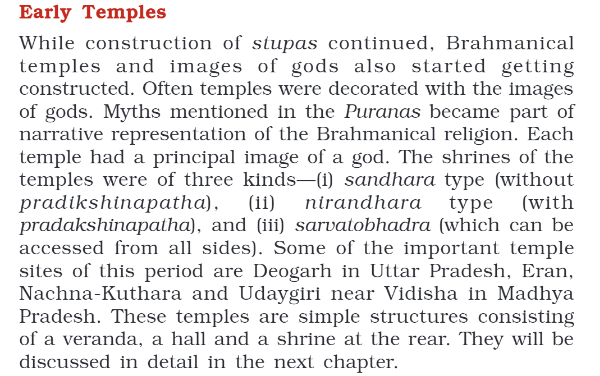Temple Architecture – Sandhara, Nirandhara and Sarvatobhadra Temples
With the construction of the Stupas, the construction of the Hindu temples also started as free standing structures. The subject matter of the deities in the Hindu temples were the mythical stories narrated in the Puranas. There were three kinds of the temples on the basis of access and the circumambulatory path built in it.
- Sandhara: These types of the temples have a square sanctum enclosed by a gallery of pillars meant for Pradakshina. Thus, the Sandhara temples have a Pradakshinapatha.
- Nirandhara: This type of temples do NOT have Pradakshinapathas
- Sarvatobhadra: These types of the temples have four functional doors on cardinal direction and also a Pradakshinapatha with a row of 12 pillars around the santum sanctorum. These types of temples could be accessed from all sides.
The earliest temples of India include the Dasavatar temple at Deogarh, in Uttar Pradesh, Nachna-Kuthara and Udaygiri near Vidisha in Madhya Pradesh. All of these temples are simple structures consisting of a veranda, a hall and a shrine at the rear.
Originally written on
April 25, 2016
and last modified on
September 12, 2022.


Atul Singh
June 11, 2015 at 6:30 pmPlease correct this article. As per several resources Sandhara Temple is a temple WITH Pradakshinapatha. While as Nirandhara is a temple WITHOUT Pradakshinapatha.
GKToday
June 11, 2015 at 6:43 pmHello, Thank you for pointing this out. The article has been updated.
Howard Roark
June 30, 2016 at 9:00 pmClass 11th Indian Art NCERT page 32 states Sandhara without Pradikhshinapath and Nirandhara with Pradikhshinapath. Is that wrong?
GKToday
July 1, 2016 at 9:59 amHello, If you are talking about below screenshot, the information in NCERT book is an error.

Garbhagraha with Pradakshinapatha is Sandhara while that without it is Nirandhara. Kindly refer to other sources or search in Google Books.
Howard Roark
July 11, 2016 at 9:35 pmSir, thanks a lot. Keep guiding.
Rohit
May 26, 2020 at 11:07 amThanks so much sir…for this imp. Information